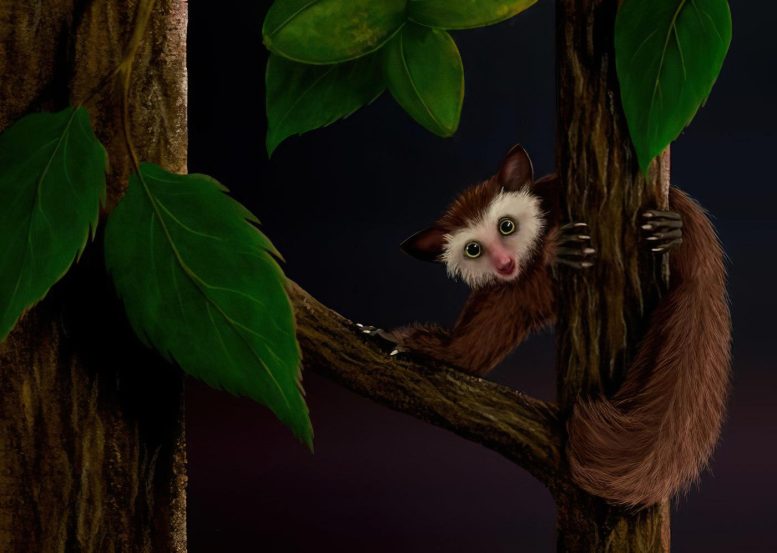
Researchers have uncovered the history of Ekgmowechashala, a primate that lived in North America 30 million years ago. By connecting it to similar species in China, they suggest it was an immigrant species, providing insights into primate evolution and the effects of environmental changes. Illustration of Ekgmowechashala, the last primate to inhabit North America before humans. Credit: Kristen Tietjen, scientific illustrator with the KU Biodiversity Institute and Natural History Museum.
The story of Ekgmowechashala, the last primate in North America before Homo sapiens or Clovis people, reads like a spaghetti western: A grizzled and mysterious loner, against the odds, ekes out an existence on the American Plains.
Except this tale unfolded about 30 million years ago, just after the Eocene-Oligocene transition during which North America saw great cooling and drying, creating an increasingly inhospitable landscape for warmth-loving primates.
Now, paleontologists from the University of Kansas and the Institute of Vertebrate Paleontology and Paleoanthropology in Beijing have recently published evidence in the Journal of Human Evolution shedding light on the long-standing saga of Ekgmowechashala, based on fossil teeth and jaws found in both Nebraska and China.
Discovery and Analysis
To do so, the researchers first had to reconstruct its family tree, a job helped by the discovery of an even more ancient Chinese “sister taxon” of Ekgmowechashala the team has named Palaeohodites (or “ancient wanderer”). The Chinese fossil discovery resolves the mystery of Ekgmowechashala’s presence in North America, showing it was an immigrant rather than the product of local evolution.
“This project focuses on a very distinctive fossil primate known to paleontologists since the 1960s,” said lead author Kathleen Rust, a doctoral candidate in paleontology at KU’s Biodiversity Institute and Natural History Museum. “Due to its unique morphology and its representation only by dental remains, its place on the mammalian evolutionary tree has been a subject of contention and debate. There’s been a prevailing consensus leaning towards its classification as a primate. But the timing and appearance of this primate in the North American fossil record are quite unusual. It appears suddenly in the fossil record of the Great Plains more than 4 million years after the extinction of all other North American primates, which occurred around 34 million years ago.”
Linking Ekgmowechashala to Asia
In the 1990s, Rust’s doctoral adviser and co-author Chris Beard, KU Foundation Distinguished Professor and senior curator of vertebrate paleontology, collected fossils from the Nadu Formation in the Baise Basin in Guangxi, China, that closely resembled the Ekgmowechashala material known from North America. By that time, Ekgmowechashala was notoriously enigmatic among North American paleontologists.
“When we were working there, we had absolutely no idea that we would find an animal that was closely related to this bizarre primate from North America, but literally as soon as I picked up the jaw and saw it, I thought, ‘Wow, this is it,’” Beard said. “It’s not like it took a long time, and we had to undertake all kinds of detailed analysis — we knew what it was. Here in KU’s collection, we have some critical fossils, including what is still by far the best upper molar of Ekgmowechashala known from North America. That upper molar is so distinctive and looks quite similar to the one from China that we found that it kind of seals the deal.”
Beard left it to Rust to conduct the morphological analysis that tied Ekgmowechashala and its cousin Palaeohodites from China in a phylogenetic tree to establish their evolutionary relationships.
In the course of the work, Rust was able to draw conclusions about how Ekgmowechashala came to be discovered in Nebraska, millions of years after its fellow primates died out in the continent’s fossil record.
“We collected a substantial amount of morphological data to create an evolutionary tree using a phylogenetic reconstruction software and algorithm,” Rust said. “This evolutionary tree suggests a close evolutionary relationship between North American Ekgmowechashala and Palaeohodites from China, which Chris and his colleagues discovered in the 1990s. The results from our analysis unequivocally supports this hypothesis.”
The KU researchers said their discovery is not only exciting in terms of discovering a new primate species from late Eocene China — but also in settling the origin story of Ekgmowechashala. Based on their investigation, Ekgmowechashala did not descend from an older North American primate that somehow survived the cooler and drier conditions that caused other North American primates to go extinct. Rather, its ancestors crossed over the Beringian region millions of years later, anticipating the route followed by the first Native Americans much later in time.
“Our analysis dispels the idea that Ekgmowechashala is a relic or survivor of earlier primates in North America,” Rust said. “Instead, it was an immigrant species that evolved in Asia and migrated to North America during a surprisingly cool period, most likely via Beringia.”
Understanding the Lazarus Effect
Species like Ekgmowechashala that show up suddenly in the fossil record long after their relatives have died off are referred to as “Lazarus taxa” after the biblical figure who was raised from the dead.
“The ‘Lazarus effect’ in paleontology is when we find evidence in the fossil record of animals apparently going extinct — only to reappear after a long hiatus, seemingly out of nowhere,” Beard said.
“This is the grand pattern of evolution that we see in the fossil record of North American primates. The first primates came to North America about 56 million years ago at the beginning of the Eocene, and they flourished on this continent for more than 20 million years. But they went extinct when climate became cooler and drier near the Eocene-Oligocene boundary, about 34 million years ago. Several million years later Ekgmowechashala shows up like a drifting gunslinger in a Western movie, only to be a flash in the pan as far as the long trajectory of evolution is concerned. After Ekgmowechashala is gone for more than 25 million years, Clovis people come to North America, marking the third chapter of primates on this continent. Like Ekgmowechashala, humans in North America are a prime example of the Lazarus effect.”
Rust and Beard were joined in the work by co-authors Xijun Ni of the Chinese Academy of Sciences, Beijing, and Kristen Tietjen, scientific illustrator with the KU Biodiversity Institute and Natural History Museum.
According to Rust, the tale of Ekgmowechashala is worth people’s attention because it happened in an era of profound environmental and climatic changes, much like our own that’s driven by human activity.
“It’s crucial to comprehend how past biota reacted to such shifts,” she said. “In such situations, organisms typically either adapt by retreating to more hospitable regions with available resources or face extinction. Around 34 million years ago, all of the primates in North America couldn’t adapt and survive. North America lacked the necessary conditions for survival. This underscores the significance of accessible resources for our non-human primate relatives during times of drastic climatic change.”
The study is also a part of a larger story that represents the earliest chapters of our own evolutionary journey that ultimately led to our own species, Rust said.
“Understanding this narrative is not only humbling, but also helps us appreciate the depth and complexity of the dynamic planet we inhabit,” she said. “It allows us to grasp the intricate workings of nature, the power of evolution in giving rise to life, and the influence of environmental factors.”
Reference: “Phylogeny and paleobiogeography of the enigmatic North American primate Ekgmowechashala illuminated by new fossils from Nebraska (USA) and Guangxi Zhuang Autonomous Region (China)” by Kathleen Rust, Xijun Ni, Kristen Tietjen and K. Christopher Beard, 6 November 2023, Journal of Human Evolution.
DOI: 10.1016/j.jhevol.2023.103452









Merely from dental remains we can tell that Eki-Eki-Eki-P’Kaing-Zumboingen-I ([Xijun] Ni!) was grizzled…